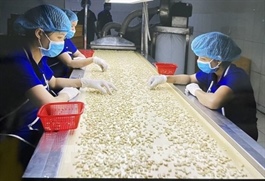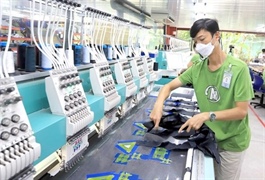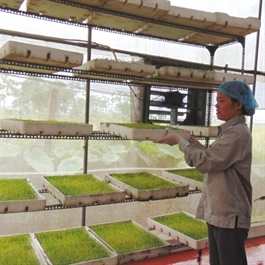Prospects for production remain patchy
Prospects for production remain patchy
Vietnam’s rebounding industrial production is still likely to suffer from slack consumption at home and slowly recovering demand in the international market.

The General Statistics Office (GSO) last week reported that while the index for industrial production (IIP) in the first two months of 2023 reduced 2.9 per cent on-year, it is estimated to have increased 5.7 per cent on-year in the same period this year.
The manufacturing and processing industry, which creates more than 80 per cent of industrial growth, expanded 5.9 per cent on-year.
The GSO said that the IIP was bouncing back but that the two-month rate of 2024 should have been higher. In February, production was almost halted for about 10 days because of the Lunar New Year taking place, leading to an 18 per cent on-month and 6.8 per cent on-year reduction.
In the first two months of the year, production of many key products in the economy witnessed an on-year decrease, such as machinery and equipment at 21.8 per cent; crude oil and natural gas at 9.4 per cent; drinks 6.6 per cent; electronics, laptops, and optical products 2.6 per cent; and transport 0.8 per cent.
What is more, despite the Lunar New Year break often inducing a soar in consumption, domestic consumption increased 8.1 per cent on-year, far lower than the on-year growth of 14.7 per cent in the same period last year.
Since Q3/2023, farm produce and garment producer Hoang Ngoc Trade and Investment JSC in Hanoi has been facing a 20 per cent reduction in outputs, while operational costs have increased by 15 per cent.
“We’re using about 300 workers instead of 500 as before, and we may have to continue our cutback in March or April if the situation fails to improve,” said company director Nguyen Thi Tuat. “Our revenues have also dipped by about 20 per cent since last October, and the rate is estimated to have reduced by about 8 per cent in the first two months of this year.”
This company has been unable to import materials from China, the biggest material provider, while local partners are also narrowing production. What is more, the company is now burdened by an obligation to pay a high lending rate of 15 per cent annually for bank loans.
In a Q4/2023 survey conducted by the GSO of over 6,500 manufacturing and processing enterprises nationwide, surveyed firms stated that they are facing massive difficulties both at home and in export markets.
Regarding industrial output, only one-third of respondents said there had been a rise in such output in Q4 as compared to Q3. In the current quarter, only 30 per cent of respondents reported an expected increase in production from the previous one.
A series of obstructions have been reported to affect business performance, such as low domestic demand (58.2 per cent), domestically made goods’ low competitiveness (49.8 per cent), weak international market demand (35.7 per cent), and general financial difficulties (32.1 per cent).
The GSO reported that 2024 so far has seen 49,300 businesses with halted operations – up 27.1 per cent as compared to the corresponding period last year. Some 10,000 enterprises stopped operations or were waiting for dissolution procedures, up 6.5 per cent, and nearly 3,700 enterprises completed such procedures. On average, about 31,500 businesses left the market in each month.
According to the Ministry of Planning and Investment, businesses will continue facing numerous difficulties this year. The Russia-Ukraine conflict, high inflation in key markets, and continued geopolitical tensions are the main causes affecting business performance.
However, in its March forecasts for Vietnam released last week, FocusEconomics stated that based on its January data when Vietnam’s industrial production output increased 18.3 per cent compared to the same month of the previous year in January, which followed December’s 5.8 per cent increase, the country’s industrial production in the months to come expected to continue flourishing.
“The trend improved, with the annual average growth of industrial production coming in at 4.2 per cent in January, up from December’s 2 per cent. When it comes to the outlook, a recovery in overseas goods demand should boost manufacturing and by extension overall industrial production in 2024 as a whole; industrial production growth in 2024 is likely to be the fastest in ASEAN,” the analysts said.
“We see industrial production expanding 9.6 per cent in 2024, up by 0.6 percentage points from one month ago, and expanding 9.6 per cent in 2025.”
Shantanu Chakraborty, country director for Vietnam of the Asian Development Bank, said that Vietnam’s domestic consumption could be boosted with increased demand from fiscal measures, supported by accommodative monetary policy to keep interest rates relatively low.
“Coordinated policy can effectively support economic recovery, considering relative price stability and weak demand. In the near term, monetary policy should be accommodative and fiscal policy expansionary,” he said. “Slow credit growth indicates that monetary policy loosening must be closely coordinated with fiscal policy implementation to effectively boost economic activities.”
According to Chakraborty, there is an opportunity for Vietnam to strengthen its competitiveness and value creation in global production networks to improve its exports.
“This could be supplemented by stronger reforms to the business environment, further strengthen attraction of foreign direct investment inflows, and enhance competitiveness to gain trade demand recovery in 2024,” Chakraborty said. “However, significant downside risks remain. External demand recovery is uncertain, while domestic difficulties from the real estate sector and significant red tape hampers domestic demand recovery.”

























